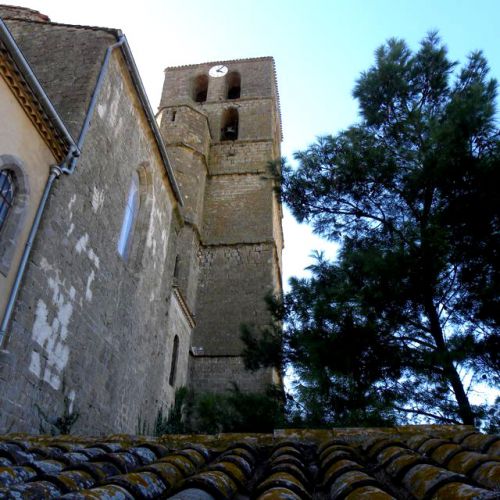Puicheric
Mary Magdalene Connection

On the "top-road" between Carcassonne and Béziers, 15km to the west of Trèbes, is the attractive village of Puicheric, just to the north of the Canal du Midi, with its church dominating the skyline; it was at one time a fortress.

That's quite a way from Rennes-le-Chateau you might think - so what's the connection?
I was there in Puicheric visiting the bookshop and the lady owner told me there was a famous painting of Mary Magdalene in the church that many people came to see. As often happens in this cases, within days the story came to me. It's a story told by Pierre Jarnac, a French writer.
While giving a lecture in Carcassonne in 1981 Jacques Rivière, the author of various books in French about the Rennes-le-Chateau mysteries, had a curious experience with regard to the painting of Mary Magdalene in the church at Rennes-le-Chateau; the one on the front of the altar. (as seen above.)
He had already projected a slide of a topographical map of the department indicating the area's highest altitudes with black lines. By sheer chance the first slide didn't clear and Rivière projected the slide of Mary Magdalene, as seen on the altar at Rennes, on top.
The black lines exactly reproduced the contours of the saint in meditation, with the city of Carcassonne sitting atop her like a crown and the bens of the River Aude following her hair. "But this is not the most amazing thing!" adds Pierre Jarnac. "At the exact point at which Mary Magdalene is staring, on the map reads the name Puicheric, in the Minervois. In the church there is a stained-glass window that displays the exact replica, though reversed, of the Rennes-le-Chateau bas-relief portraying Mary Magdalene!"
Investigation was in order.
Officially, the church, dedicated to Sainte Marie (the Virgin) was built in the 13th century, but we knew immediately a church had been on that spot for much longer than that; the village was Visigothic and the high point of it was the fortress, which would have included a chapel of some sort. In the late 5th and early 6th centuries the Visigoths were fortifying this region against the Franks from the north.

The church is large with many side chapels. There is a baptistry - where the children go to be baptised - dedicated to St.John (not the Baptist) and a splendid belltower that one can climb. There are also some rare and delicate frescoes.
We went in, turned left and left again, and there was the magnificent stained glass window of Mary Magdalene. It was similar, though reversed, but so beautiful because of the light behind it making it luminous.
So - what's the connection between the two Mary M's? You tell me!
If you want to visit the church, ring the Mairie (tel 04 68 27 89 89, standard office hours) to make an appointment.
Inscrivez-vous au blog
Soyez prévenu par email des prochaines mises à jour
Rejoignez les 97 autres membres


